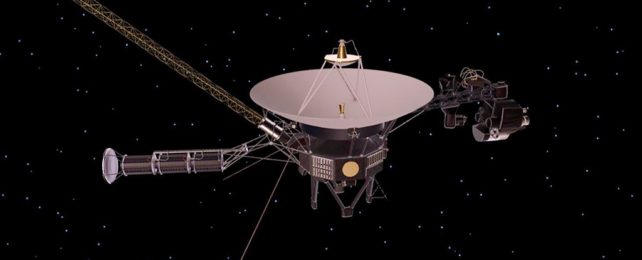The Voyager 1 space probe launched from Earth in September 1977, and is now around 23.5 billion kilometers (or 14.6 billion miles) away from home – and counting. But despite that mind-blowing distance, NASA scientists just carried out a repair job on the craft.
Since May, Voyager 1 has been sending back garbled information from its attitude articulation and control system (AACS), which is the part of the probe that ensures that its antenna is pointed towards Earth.
Although the rest of the probe continued to behave normally, the information it sent back about its health and activities didn't make any sense. Through a switch in the way data is sent back from Voyager 1, the issue has now been fixed.
"We're happy to have the telemetry back," says Suzanne Dodd, Voyager's project manager at the NASA Jet Propulsion Laboratory in California.
Scientists were able to figure out that the spacecraft had begun transmitting data through an on-board computer that was known to have stopped working years ago. The NASA team commanded Voyager 1 to switch back to the correct computer for communications.
What we don't know yet is why Voyager 1 decided to start switching up how it was sending data back to its home planet. The most likely explanation is a faulty command generated from somewhere else on the probe's electronic systems.
That in turn suggests that there's another problem somewhere else, otherwise the computer switch would never have been made. However, the Voyager 1 team is confident that the long-term health of the spacecraft isn't under threat.
"We'll do a full memory readout of the AACS and look at everything it's been doing," says Dodd. "That will help us try to diagnose the problem that caused the telemetry issue in the first place."
Voyager 1 and Voyager 2 (which actually launched a month earlier than its twin) have traveled so far in 45 years that they're now both beyond the point known as the heliopause, where the Sun's solar winds can no longer be felt and space is officially regarded as interstellar.
Despite Voyager 1 shutting down some of its systems and losing some functionality in that time, and Voyager 2 needing some troubleshooting also, both the probes continue to report back to Earth – even though a message can take around two days to travel the required distance.
The spacecraft have sent back images from close to Jupiter, Saturn, Uranus, and Neptune, and in recent years have carried on recording and analyzing the weird and wonderful experiences they're having out in space.
Voyager 1 hasn't triggered its 'safe mode' routine, which suggests it doesn't detect anything faulty, and the signal from the spacecraft hasn't weakened. All being well, it can continue reporting back for many years to come.
"We're cautiously optimistic, but we still have more investigating to do," says Dodd.
You can keep track of the probe on the Voyager Mission Status website.
